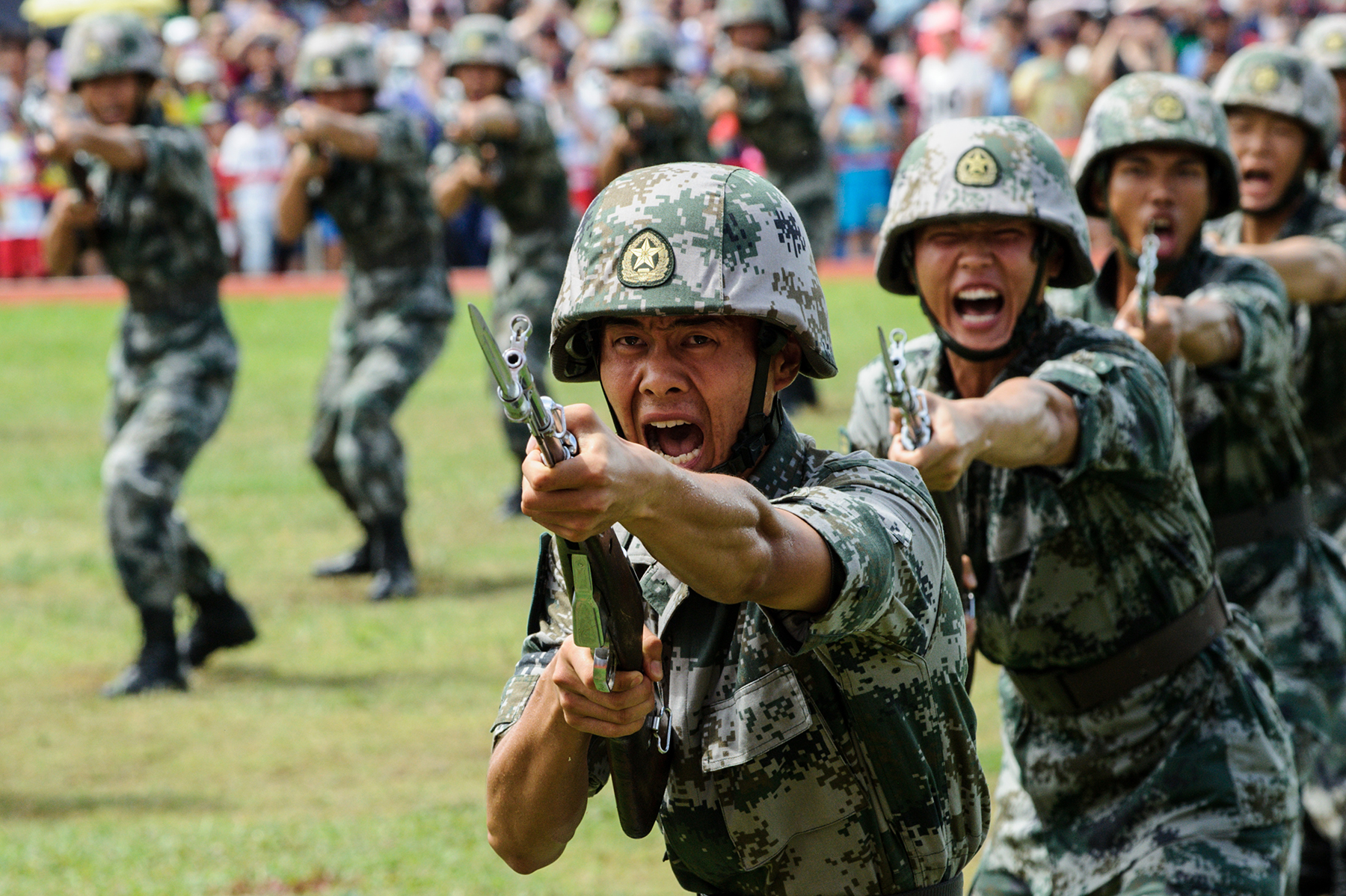Vulnerabilities Of The People’s Liberation Army

by
Dr Shiv Sastry
It cannot be easy to maintain the largest standing army in the world. Despite serial reductions in numerical strength, the People’s Liberation Army (PLA) of China now has about 2 million personnel. Information about the PLA is available in plenty, but does not go beyond the repetitive references to seven military regions (now five theatre commands) and other organisational details which make little sense to the lay reader and do not divulge much about the soldiers. This article is an attempt to examine some of the less well known or less well publicized aspects of the PLA.
Though the army is under civilian control in name – it actually comes directly under one man, currently Xi Jinping the president and leader of the Chinese communist party. The PLA serves the communist party of China, so technically it is an army that represents the 80 million members of the Chinese communist party and not all 1.4 billion Chinese. The communist party discourages nationalist loyalty and nationalist thought in the PLA to retain loyalty to the party. This involves indoctrination during the training and close control of political thought of every regiment down to platoon level by the presence of a political commissar in every unit. For India, the loyalty of the PLA to the communist party rather than China the nation probably makes no difference because the communist party’s actions translate into Chinese national actions. The only time when the PLA has to act against Chinese citizens is when there is opposition to the ruling communist party such as was seen in the Tiananmen square protests of 1989. Less well publicized are reports of excesses against the people of Tibet and Xinjiang.
Recruitment And Training
Every year the PLA replaces about 450,000 personnel who have completed their two year conscription term with the army. That means 20% of the army is turned over every year. The combat arm of the army apparently depends on about 800,000 relatively unskilled conscripts serving varying amounts of a two year stint in the army. “Conscript” is the wrong word. Chinese law states that every person between the ages of 18 and 22 years must serve two years in the army, but in practice there are more than enough young people to fill the available slots every year. However, this fact must be looked at critically because mere availability in numbers does not get the PLA the types of recruits it wants. One constant refrain from China is that they want educated people to fight in an increased informationalised battle space. The word “informationalised” is used repeatedly indicating Chinese plans of fighting wars using high technology in future, requiring soldiers whose education is higher than school graduation. It appears that the PLA was still not getting recruits of the type they desired despite the adequate absolute numbers of 18 year old school graduates available every year. This has been explained as being due to the changing demography of China caused by many decades of a “one child only” policy that has reduced the choice of youngsters available, combined with the availability of better jobs and prospects in the civilian sector.
China has responded to this human capital crisis by raising the age up to which students can be drafted into the army to 24 years (up from 22) and by lowering physical standards. Raising of the age limit allows those who have finished college to be enlisted. As regards physical standards, the minimum height is now down to 5 feet 3 inches and people who are up to 30% over standard weight are allowed. Minimum eyesight standards have also been made more lenient. There have been reports of a very high prevalence of short sightedness (myopia) among young Chinese affecting recruitment into the Air Force. Other measures include asking colleges to reserve a seat for those who get drafted, and better opportunities for those who complete their two year term in the army. Even so, post army service employment remains a problem. Despite these measures the PLA still does not have the number of educated conscripts that it wants. More people from rural areas with lesser education enter the army than the higher educated urban youth who see a better future in private jobs. Apart from the feeling that the army would not be a good career, other impediments are the fact that the new conscripts tend to get posted in faraway places in harsh environments such as Tibet and Xinjiang.
The PLA recruitment cycle is such that those who complete 2 years usually leave by September every year so there is a drop in the strength of the PLA in September. But it is not possible to say exactly how many may be leaving after their two year tenure and how many choose to continue, or are allowed to continue.
Those who opt to stay may enter specialized units. In the PLA there is not much cross movement and personnel who enter a particular career track often spend their entire career there. Training of new recruits lasts 40 days from September to December.
This involves basic training, saluting, marching, rifle handling, history of the PLA and 16 days of political indoctrination. The physical training builds up to running five kilometres three times a week. This seems like a very low target. The recruits are then posted to various units where they must be trained further. All in all it takes 9 months to make a fully trained soldier.
This creates an interesting dynamic. The PLA is fully battle ready and ready for exercises by May every year. Since recruits leave by September the US has assessed that the PLA is most ready for war in the June to September period. This in fact exactly matches the commencement of aggressive moves by the PLA on the Indian border in May-June 2020.
Overall, the PLA is top heavy and bottom heavy with a shallow middle order. There are too many officers – amounting to thirty percent and there are too many unskilled conscripts at the bottom and not enough NCOs who form the backbone of any army.
Army Exercises And Preparation For War
The PLA hardly ever exercises with foreign armies. In fact any interaction with foreign armies is discouraged because of the potentially bad political effect it may have on PLA soldiers. However it appears that the PLA’s training has tried to emulate US methods. In the past military exercises were shams where the friendly “Red” forces always won.
However this has changed with the introduction of a hostile “Blue” force which is allowed to win. After such exercises a 40 page report must be submitted where only 10% is devoted to the positives and 90% to the negatives.
Blue forces have won by launching nuclear strikes and by deceit such as capturing a Red commander by sending in people pretending to be providing humanitarian aid. This act of “cheating” has clearly been used by the Chinese in the June 15th 2020 face-off with Indian troops in Galwan where the brave Indian Commanding Officer Col. Santosh Babu was killed by deceit when he went unarmed for negotiation.
In other “Red” versus “Blue” Chinese military war-games, it was assessed that Red (China) could defeat the US (Blue) by using unconventional “assassin’s mace” methods that break conventional rules such as knocking out enemy satellites or using electromagnetic pulses.
One can expect that in the case of a serious India-China face off, China might try to make up for reverses by knocking off Indian satellites or a decapitation strike on Delhi. It is to be hoped that Indian military planners have gamed this “unconventional attack” possibility into their war game scenarios.
Corruption
For about two decades after the Sino-Vietnam war PLA funding was reduced and the army had to generate its own funding by entering into business and industry. This led to a great deal of corruption and illegal profiteering of the PLA.
There has been a clampdown on this in recent years but corruption has not vanished. Reports keep cropping up of the arrest of erring corrupt officers.
Housing in areas where officers are posted followed by failure to vacate houses are renting the accommodation to others is one known source of corruption that has led to a housing shortage.
Personal Life, Marriage And Housing
Chinese law does not allow marriage for men until they are at least 22 years old. In the army, men cannot marry until they are 25 years of age and women until they are 23. There are more men than women in China – with the shortage of women amounting to 30 million less than men, and 200 million people of marriageable age remaining unmarried.
After joining the army, new recruits and men must stay in barracks and married couples cannot live together until the spouse has put in 10 to 12 years of army service. They are also not allowed to marry women from their own unit for unknown reasons. Yet the PLA apparently encourages marriages.
They try to encourage marriages within the army by conducting blind dates in gala functions. Such events might combine a mass marriage of couples previously engaged by army dating programs. They may also feature stories from the lives of those who met and married in this way. Intra-army marriages are encouraged in other ways.
China has a system known as hukou under which rural residents cannot legally move to urban areas. However in the case of military arranged marriages one partner of the couple will be permitted to change hukou from rural to urban if need be.
Acquiring the right to live in an urban area offers great advantages for education and jobs but such a move is not a right in China. It is offered as a privilege to military couples.
There is a shortage of housing accommodation for married couples. This can lead to long separations between husband and wife. However the regulations for annual leave have gradually been made more lenient from leave once in four years, later once in two years to the present where annual leave is allowed for 40 to 45 days a year.
As mentioned earlier the housing shortage is caused in part by corrupt senior officers misusing their housing privileges and owning multiple houses at multiple locations.
Even after long separations an aggrieved wife cannot file for divorce from an army husband without his permission. The law is heavily weighted in favour of the male serving member of the military.
Oxygen Enriched Barracks
Of all the privileges offered as incentives for personnel to join and stay in the PLA one of the most unusual ones has to be oxygen enriched barracks in high altitude postings such as Tibet. Oxygen enrichment of living quarters has been used in the mountainous regions of China for workers who normally live at low altitude but need to work at high altitude.
However if the human body gets the extra oxygen that it needs at high altitude it will not acclimatize to that altitude. This is perfectly fine for a day job in a high altitude factory or a mine from where a worker can return to his accommodation for a good night’s rest. However its use for soldiers is puzzling.
If soldiers do not acclimatize to high altitudes and need to get back to an oxygen enriched bedroom at night, their ability to rough it out in combat at high altitude will be restricted.
While it is tempting to call PLA soldiers “softies” for this, the deeper reasons might be reluctance of personnel to serve in Tibet. Despite better salaries and the pumping of resources into Tibet the Chinese have not managed to raise the percentage of Han Chinese in Tibet beyond 5% – which is a low figure considering that Tibet itself has a population of 3 million compared with over a billion Han Chinese in China.
It may be that the officer-heavy PLA want the comfort of oxygen enrichment to get a good night’s sleep in Tibet or the political officers who do not belong in the same category as combat troops need that luxury. Another reason might be that there are no staging areas between Tibet and Xinjiang or eastern China where soldiers can ascend gradually for 15 days of acclimatization.
Aside from that, the logistics of carrying oxygen generators, cylinders and extra power supply over and above the logistical needs of an army add an extra burden in a hostile region for which everything from food to fuel has to be shipped in from faraway mainland China.
Conclusion
In conclusion it may be said that the PLA has some very definite weaknesses. But efforts are being put in to remedy the weaknesses. In a war scenario it is unlikely that the Chinese will sit back and allow their weaknesses to halt them.
They are more than likely to wage unconventional war using tactics like knocking out satellites or causing mass civilian casualties to force an adversary into capitulation. The Chinese cannot be trusted to remain within the ambit of agreements and conventions.
Dr Shiv Sastry is a retired surgeon with a long term interest in military aviation. The views expressed are the author’s own




